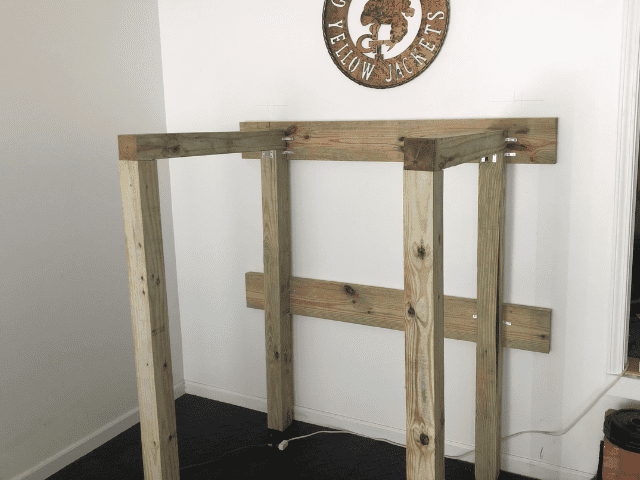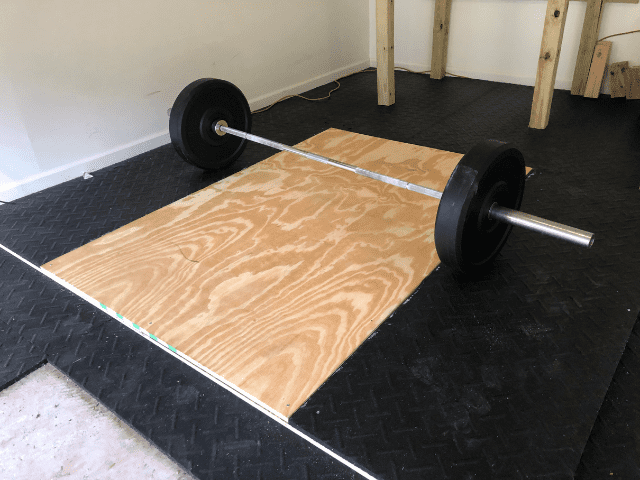Buying Lifting Equipment vs Build It Yourself (Which is Better?)
If you know your way around a hammer and nails, you’d be surprised at how many pieces of equipment you can build yourself for your garage gym. So far with my gym, I’ve built everything from an Olympic lifting platform to a heavy sandbag. I’ve saved myself a good chunk of money in the process which I’ve used to, well, buy more equipment.
However, I also have plenty of stuff I’ve bought as well. The last couple of things I’ve bought for my garage gym are a pair of rings and a pullup bar.
So, if you’re trying to decide on whether to buy lifting equipment vs build it yourself, how do you know which is better?
When deciding if you should buy it or build it, there are four rules to consider. First, is the build within your skill level? Second, how much time and effort is it going to take to build? Third, how much is buying the equipment going to cost vs buying all the materials to build it? Finally, can you build something safe?
For every piece of equipment that’s going to go in my garage gym, I run it through these four rules to see whether buying it or building it makes the most sense. Let me explain each rule a bit further.
Buying Lifting Equipment vs Build it Yourself
Can You Build It? Yes, You Can!

The first thing you need to determine is whether the piece of equipment that you’re considering making is within your building abilities. After all, not all of us are Bob the Builder. If building a particular piece of equipment looks outside of your ability then the next three rules are irrelevant.
It’s not just about ability too. You also need to have the proper resources (aka tools) as well.
For example, I built a Squat Stand that is attached to one of my walls. It was a super simple build. It really wasn’t much more than 4x4s and brackets screwed together. My collection of tools is much better than it was 10 years ago, but it’s still basic at best. I built the whole thing using a handsaw, measuring tape and a cordless screwdriver.
This was all within my abilities and resources.
I’ve seen some DIY Squat Racks though that are LEGIT full wood racks complete with holes for j hooks and attachments. Some even have pullup bars and lat pulldown attachments. These racks are unbelievably impressive. My guess is though, they probably weren’t built with a hand saw.
Since that kind of rack is outside my current resources, it would fail rule number 1. However, if you have a workshop that would make Ron Swanson proud, then most projects will probably pass Rule 1.
As impressive as those racks are though, in my mind, they violate two of my other rules when it comes to buying vs building.
How Much is Your Time Worth?
Time is our most valuable resource.
After I figure out if I can build it, I start to decide if I should build it. This is where Rule 2 comes in.
When deciding if I should build something myself, the first thing I consider is how long is this going to take me to build? Is this going to be a 30-minute project or a 3-day project? Taking on a project that is going to take me 20 hours to build so I can save $60 on the cost of a squat rack is not going to be worth it to me.
That’s for me personally. While I do get satisfaction in building and then using something I’ve built myself, it’s still mostly a means to an end for me. I am trying to get a piece of equipment that is functional and going to save me money building myself.
I mentioned the full racks that I’ve seen that are essentially beautifully carved pieces of art. I have to imagine that the actual building of the rack was just as enjoyable to that person as is using it. If that’s you and the 20+ hours that it’s going to take you for that project is something you look forward to, then by all means, go for it.
I honestly wish I was more into woodworking than I am. I do enjoy it more than I used to so maybe I’ll evolve into a Swanson-esque woodworker after all at some point down the road.
Cost Analysis: Buy vs Build

If a potential project has passed the first two rules, then it’s on to a cost analysis to see if it makes sense financially.
There are some pieces of lifting equipment that are outrageously expensive. Platforms are one of the best examples of this. You can easily spend over $1000 on a platform. A top-of-line Eleiko platform, over $3000.
I built my platform for less than $200. Is my platform as refined as the $1000 one? Nope. But, it has character and I love the satisfaction of lifting on a platform every day that I built myself. (See, there is hope for me yet Ron)
Building my own platform easily saved me a few hundred dollars, but sometimes building something yourself doesn’t end up being as cost-effective as you might think. This is especially true if you catch equipment on clearance or find it used.
I just picked up this Wall Mounted Pull-Up Bar from Titan for $53 on clearance. For $53 I have an iron pull-up bar that is going to show up in the mail and a few screws later will be up on my wall.
To build my own I would have needed 2x4s, possibly 4x4s, some type of piping, bolts and screws. It would have ended up costing me close to $50 (if not more) to build it myself. A 2-foot piece of 1″ galvanized pipe from Lowe’s costs $16 alone. This is not to mention all the extra time and effort it would have taken for me to build it myself.
Sometimes just buying what you need can end up being cheaper than building it yourself.
Will It Be Safe?
Last, but absolutely not least – Are you 100% confident that whatever you build is going to be safe to use?
There is a reason why most weightlifting equipment is made out of steel. Thick, durable steel that is welded and bolted together. If you are racking a 500lb squat, the rack you are putting it in better work – EVERY TIME.
If the rack you decided to build yourself cracks and/or falls apart at the wrong time you could seriously injure yourself, or worse.
Granted, some things are a little more forgiving than others. If your DIY sandbag rips, you may end up with a mess on your hand, but sand leaking everywhere is probably not going to hurt anyone.
But, I cannot emphasize this enough: If you’re building something that has to be safe every single time, then you better be 100% confident in what you are building. If you’re not, buy it.
Final Thoughts
Most often whether you decide to build your next piece of lifting equipment yourself or just buy it ready to go comes down to personal preference. Normally, it comes down to deciding whether it’s worth trading the time and effort to build it yourself versus the added cost of the convenience of just buying something.
By following these 4 rules you’ll be able to decide if you’re better off buying lifting equipment vs building it yourself. Just make sure that whatever you decide to do, make sure it’s going to keep you safe when you train!
Stay Strong!

